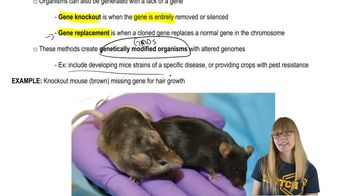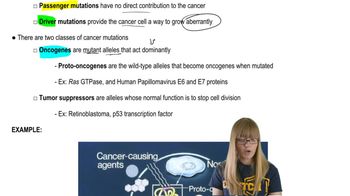Table of contents
- 1. Introduction to Genetics51m
- 2. Mendel's Laws of Inheritance3h 37m
- 3. Extensions to Mendelian Inheritance2h 41m
- 4. Genetic Mapping and Linkage2h 28m
- 5. Genetics of Bacteria and Viruses1h 21m
- 6. Chromosomal Variation1h 48m
- 7. DNA and Chromosome Structure56m
- 8. DNA Replication1h 10m
- 9. Mitosis and Meiosis1h 34m
- 10. Transcription1h 0m
- 11. Translation58m
- 12. Gene Regulation in Prokaryotes1h 19m
- 13. Gene Regulation in Eukaryotes44m
- 14. Genetic Control of Development44m
- 15. Genomes and Genomics1h 50m
- 16. Transposable Elements47m
- 17. Mutation, Repair, and Recombination1h 6m
- 18. Molecular Genetic Tools19m
- 19. Cancer Genetics29m
- 20. Quantitative Genetics1h 26m
- 21. Population Genetics50m
- 22. Evolutionary Genetics29m
19. Cancer Genetics
Cancer Mutations
Problem 6c
Textbook Question
Radiation is frequently used as part of the treatment of cancer. The radiation works by damaging DNA and components of the cell. Is there a risk of damage to noncancer cells?
 Verified step by step guidance
Verified step by step guidance1
Understand that radiation therapy targets rapidly dividing cells, which includes both cancerous and some noncancerous cells.
Recognize that noncancerous cells in the treatment area can also be affected by radiation, leading to potential damage.
Consider that the extent of damage to noncancerous cells depends on factors such as the dose of radiation and the sensitivity of the cells.
Acknowledge that while noncancerous cells can repair some of the damage, repeated exposure may lead to cumulative effects.
Note that modern radiation therapy techniques aim to minimize exposure to healthy cells while maximizing the dose to cancer cells.
Recommended similar problem, with video answer:
 Verified Solution
Verified SolutionThis video solution was recommended by our tutors as helpful for the problem above
Video duration:
2mPlay a video:
Was this helpful?
Key Concepts
Here are the essential concepts you must grasp in order to answer the question correctly.
DNA Damage
DNA damage refers to alterations in the DNA structure that can lead to mutations or cell death. In cancer treatment, radiation therapy targets rapidly dividing cancer cells by inducing breaks in their DNA. However, this process can also affect normal cells, leading to potential side effects.
Recommended video:
Guided course

DNA Proofreading
Radiation Therapy
Radiation therapy is a medical treatment that uses high doses of radiation to kill or inhibit the growth of cancer cells. It works by damaging the DNA of the targeted cells, making it difficult for them to reproduce. While effective against tumors, it can also inadvertently harm surrounding healthy tissues.
Recommended video:
Guided course

Transgenic Organisms and Gene Therapy
Cell Cycle and Repair Mechanisms
Cells go through a cycle of growth and division, and they have mechanisms to repair DNA damage. Normal cells can often repair themselves after radiation exposure, but cancer cells may lack these effective repair pathways. Understanding the differences in repair capabilities is crucial for assessing the risks of radiation damage to noncancer cells.
Recommended video:
Guided course

Repair Pathways

 4:50m
4:50mWatch next
Master Cancer Mutations with a bite sized video explanation from Kylia Goodner
Start learningRelated Videos
Related Practice


